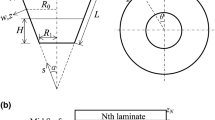Abstract
The finite element vibration analysis of laminated spherical shell panels with rectangular embedded delamination is carried out based on the third-order shear deformation theory of Sanders. In the finite element formulation for the embedded delamination, the seven degrees of freedom per each node are used with transformations in order to fit the displacement continuity conditions at the delamination region. The numerical results obtained for plates and shells with delaminations are in good agreement with those of other preceding investigations. The new results for composite shell structures in this study mainly show the significant effect of the interactions between the radius-length ratio and other various parameters, for example, embedded delamination size, fiber angles, the number of layer and location of delamination in the layer direction.
Similar content being viewed by others
References
Bhimaraddi, A. and Stevens, L. K. (1984). “A high order theory for free vibration of orthotropic, homogeneous and laminated rectangular plates.” Journal of Applied Mechanics, Vol. 51, pp. 195–198.
Ferreira, A. J. M., Roque, C. M. C., and Jorge, R. M. N. (2006). “Static and free vibration analysis of composite shells by radial basis functions.” Engineering Analysis with Boundary Elements, Vol. 30, pp. 719–733.
Ganapathi, M., Patel, B. P., and Pawargi, D. S. (2002). “Dynamic analysis of laminated cross-ply composite non-circular thick cylindrical shells using higher-order theory.” International Journal of Solids and Structures, Vol. 39, pp. 5945–5962.
Kant, T., Varaiya, J. H., and Arora, C. P. (1990). “Finite element transient analysis of composite and sandwich plates based on a refined theory and implicit time integration schemes.” Computers and Structures, Vol. 36, No. 3, pp. 401–420.
Karmakar, A., Roy, H., and Kishimoto, K. (2005). “Free vibration analysis of delaminated composite pretwisted shells.” Aircraft Engineering and Aerospace Technology: An International Journal, Vol. 77, No. 6, pp. 486–490.
Kumar, A. and Shrivastava, R. P. (2005). “Free vibration of square laminates with delamination around a central cutout using HSDT.” Composite Structure, Vol. 70, No. 3, pp. 317–333.
Lee, S. Y. and Chang, S. Y. (2010). “Dynamic instability of delaminated composite structures with various geometrical shapes.” Journal of the Korean Society for Advanced Composite Structures, Vol. 1, pp. 1–8.
Lee, S. J. and Reddy, J. N. (2004). “Vibration suppression of laminated shell structures investigated using higher order shear deformation theory.” Smart Materials and Structures, Vol. 13, pp. 1176–1194.
Lee, S.Y. and Wooh, S. C. (2004). “Finite element vibration analysis of composite box structures using the high order plate theory.” Journal of Sound and Vibration, Vol. 277, pp. 801–814.
Lee, S. Y., Wooh, S. C., and Yhim, S. S. (2004). “Dynamic behavior of folded composite plates analyzed by the third order plate theory.” International Journal of Solids and Structures, Vol. 41, pp. 1879–1892.
Messina, A. and Soldatos, K. P. (1999). “Vibration of completely free composite plates and cylindrical shell panels by a higher-order theory.” International Journal of Mechanical Sciences, Vol. 41, pp. 891–918.
Murthy, M. V. V. (1981). “An improved transverse shear deformation theory for laminated anisotropic plates.” NASA Technical paper 1903, pp. 1–37.
Parthi, P. K., Bhattacharyya, S. K., and Sinha, P. K. (2001). “Hydrothermal effects on the dynamic behavior of multiple delaminated composite plates and shells.” Journal of Sound and Vibration, Vol. 248, No. 2, pp. 195–214.
Reddy, J. N. (2004). Mechanics of laminated composite plates and shells: Theory and analysis, CRC Press, New York.
Reddy, J. N. and Liu, C. F. (1985). “A higher-order shear deformation theory for laminated elastic shells.” International Journal of Engineering Science, Vol. 23, pp. 319–330.
Sanders, J. L. Jr. (1959). An improved first approximation theory of thin shells, NASA TR-R24.
Sanders, J. L. Jr. (1963) “Nonlinear theories for thin shells.” Applied Mathematics, Vol. 21, pp. 21–36.
Zukas, J. A. and Vinson, J. R. (1971). “Laminated transversely isotropic cylindrical shells.” Journal of Applied Mechanics, Vol. 38, pp. 400–407.
Author information
Authors and Affiliations
Corresponding author
Rights and permissions
About this article
Cite this article
Noh, MH., Lee, SY. Free vibration of composite shells containing embedded delaminations based on the third-order shear deformation theory. KSCE J Civ Eng 16, 1193–1201 (2012). https://doi.org/10.1007/s12205-012-0931-z
Received:
Revised:
Accepted:
Published:
Issue Date:
DOI: https://doi.org/10.1007/s12205-012-0931-z




